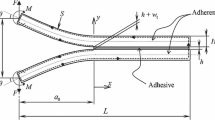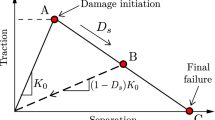Abstract
The deformation and failure mechanisms of toughened high strength adhesives used in the automotive industry are very complex and require advanced numerical models for crashworthiness simulation. The theoretical background of two new modelling approaches for thin adhesive layers is presented: firstly, a simplified elastic damaging node-to-element tied interface model approach for convenient and efficient modelling, and secondly a detailed modelling approach for improved accuracy using an elasto-viscoplastic solid element representation of the adhesive layer. The material model parameters required for both approaches are determined by a comprehensive set of experiments, including quasi-static and dynamic adhesive coupon testing, fracture toughness testing, and quasi-static tension/shear (and combined) testing of thin adhesive layers. A more complex adhesively joined assembly of two aluminium extrusions subjected to quasi-static (QS) and dynamic loading serves as the final validation example for both modelling approaches. Good agreement of experiments and numerical predictions was observed for both modelling approaches.
Similar content being viewed by others
Abbreviations
- G IC , G IIC :
-
Critical strain energy release rate for Mode I and Mode II loading
- \({\delta_{I}, \delta_{II}}\) :
-
Relative out-of-plane (Mode I) and in-plane (Mode II) interface element displacements
- \({{\sigma_{I}, {\sigma_{II}}}}\) :
-
Out-of-plane (Mode I) and in-plane (Mode II) interface element stresses
- E, G :
-
Young’s modulus, shear modulus
- dA, dW :
-
Infinitesimal area and energy
- d I , d II :
-
Out-of-plane (Mode I) and in-plane (Mode II) damage functions
- < x > + :
-
Operator returns ‘x’ if x > 0 and 0 otherwise
- sup t≤ τ (x):
-
Supremum of x: Maximum of x within the range 0 ≤ t≤ τ
- I 1, J 2 :
-
First invariant of the stress tensor and second invariant of the stress deviator
- σ m :
-
Hydrostatic stress
- σ e :
-
Equivalent von Mises stress
- I :
-
Identity matrix
- \({\sigma,\varepsilon^{e},\varepsilon ^{p}}\) :
-
Stress tensor, elastic and plastic strain tensor
- E :
-
Elasticity matrix
- σ x , τ xy :
-
Axial stress and torque shear stress
- \({\sigma _T \left( {\varepsilon _T^p } \right)}\) :
-
Tensile strain hardening curve
- Φ:
-
Yield function
- α, β :
-
Shape parameters for the yield function and the flow potential
- σ0 :
-
Shift stress value representing the centre of the yield locus
- \({\tilde{\sigma}}\) :
-
Special effective equivalent stress
- \({\dot{\varepsilon}_T^{p}}\) :
-
Plastic strain rate threshold
- C :
-
Fitting parameter for the strain rate model
- \({\dot{\lambda}}\) :
-
Plastic multiplier
- DCB:
-
Double Cantilever Beam
- DF:
-
Deshpande and Fleck
- DYN:
-
Dynamic
- Exp, Sim:
-
Experiment and Simulation
- FE:
-
Finite Element
- JC:
-
Johnson and Cook
- QS:
-
Quasi-static
References
ABAQUSTM User Manual, http://abaqus.com
ASTM draft standard D30.06. (1993) Protocol for inter-laminar fracture testing, End-Notched Flexure (ENF)
Audi TT (2006) Automobil Industries, special issue
Blackman BRK, Kinloch AJ, Paraschi M, Teo WS (2003). Measuring the mode I adhesive fracture energy, GIC, of structural adhesive joints: the results of an international round-robin. Int J Adhesion Adhesives 23(4):293–305
BetamateTM 1496: Technical data sheet http://automotive.dow.com/materials/products/betamate/bmate96.htm
Camanho PP, Davila CG, Ambur DR (2001) Numerical Simulation of Delamination Growth in Composite Materials. NASA Langley Research Center, Hampton Virginia, NASA TP-2001-211041
Camanho PP, Matthews FL (1999). Delamination onset prediction in mechanically fastened joints in composite laminates. J Compos Mater 33:906–927
Deshpande VS, Fleck NA (2000). Isotropic constitutive models for metallic foams. J Mech Phys Solids 48:1253–1283
Disse T (2004) Untersuchungen zum geschwindigkeitsabhängigen Festigkeits- und Verformungsverhalten von Klebverbindungen. Dissertation, Universität Paderborn, Shaker Verlag
Drucker DC, Prager W (1952) Soil mechanics and plastic analysis in limit design. Quarterly Appl Math 10(2):157–165
FOSTA P477 (2000–2002) Untersuchungen zum Crashverhalten geklebter und hybridgefügter Stahlblechverbindungen.
FOSTA project P593 (2002–2004) Methodenentwicklung zur Berechnung und Auslegung geklebter Stahlbauteile für den Fahrzeugbau.
FOSTA project P676 (2005–2007) Methodenentwicklung zur Berechnung von höherfesten Stahlklebverbindungen des Fahrzeugbaus unter Crashbelastung
Greve L, Pickett AK (2005). Delamination testing and modelling for composite crash simulation, Composite Science and Technology 66(6) : 816–826
Hillerborg A, Modeer M, Petersson PE (1976). Analysis of crack formation and crack growth in concrete by means of fracture mechanics and finite elements. Cement Concrete Res 6:773–782
ISO international Standard DIS15024. Fibre-reinforced plastic composites—Determination of Mode I inter-laminar fracture toughness, GIC, for unidirectionally reinforced materials.
Johnson AF, Pickett AK, Rozycki P (2001). Computational methods for predicting impact damage in composite structures. Compos Sci Tech 61(15):2183–2192
Johnson GR, Cook WH (1985) Fracture characteristics of three metals subjected to various strain, strain rates, temperatures and pressures. Eng Fract Mech 21(1):31–48
Mahnken R, Schlimmer M (2005) Simulation of strength difference in elasto-plasticity for adhesive materials. Int J Numer Method Eng 63(10):1461–1477
Memhard D, Andrieux F, Sun D-Z, Feucht M, Frank T, Kolling S (2005) Entwicklung und Anwendung von Ersatzmodellen für die Anwendung von Klebverbindungen unter Crashbelastung. 4. LS-DYNAAnwenderforum, Bamberg 2005
PAM-CRASHTM PAM-SAFETM Version 2005 Manuals, Engineering System International, www.esi-group.com
Sato C, Ikegami K (1999) Strength of adhesively-bonded butt joints of tubes subjected to combined high-rate loads. J Adhesion 70:57–73
Schlimmer M (1974) Fließverhalten plastisch kompressibler Werkstoffe. Dissertation, Technische Hochschule Aachen
Steinbrecher G, Buchman A, Sidess A, Sherman D. (2006) Characterization of the mode I fracture energy of adhesive joints”, International Journal of Adhesion and Adhesives 26(8): 644–650
von Mises R (1928). Mechanik der plastischen Formanderung von Kristallen. ZAMM 8:161–185
Author information
Authors and Affiliations
Corresponding author
Rights and permissions
About this article
Cite this article
Greve, L., Andrieux, F. Deformation and failure modelling of high strength adhesives for crash simulation. Int J Fract 143, 143–160 (2007). https://doi.org/10.1007/s10704-007-9054-9
Received:
Accepted:
Published:
Issue Date:
DOI: https://doi.org/10.1007/s10704-007-9054-9




